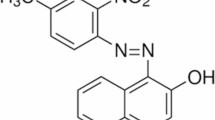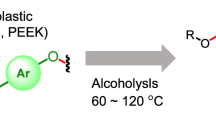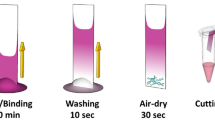Abstract
‘LUXOL’ fast blue G (Du Pont), the diarylguanidine salt of a sulphonated azo dye, forms complexes stoichiometrically with phospholipids1. These complexes have been found to be insoluble in a varying pattern in the lower alcohols. For this study phospholipid-dye complexes were prepared with the same dye and phosphatidyl choline, phosphatidyl serine, phosphatidyl ethanolamine, phosphatidyl inositol, or sphingomyelin. The complexes were produced by bringing together the dye and phospholipid in pyridine solution. After evaporation of the solvent, excess uncomplexed dye or phospholipid could be removed by the alcohol in which the complex was insoluble. The solubility of the complexes in methanol, ethanol, isopropanol and isobutanol was determined. The results are summarized in Table 1. It was found that the complexes were soluble to the extent of at least 0.1 per cent or else were completely insoluble in the alcohols used. When alcoholic solutions of dye and phospholipid were mixed, precipitates were formed in those alcohols in which the particular complex had been found to be insoluble. The absorption maximum for the dye alone in the alcohols used is 597 mµ. When alcoholic solutions of the dye and phospholipid were mixed, the absorption maximum dropped to 570 mµ, before precipitation took place. If the precipitate was then centrifuged and the deposit redissolved in methanol or an alcohol in which it is soluble the absorption maximum was found to return to 597 mµ. This can be taken as evidence of dissociation where complexes are marked soluble in Table 1.
This is a preview of subscription content, access via your institution
Access options
Subscribe to this journal
Receive 51 print issues and online access
$199.00 per year
only $3.90 per issue
Buy this article
- Purchase on SpringerLink
- Instant access to full article PDF
Prices may be subject to local taxes which are calculated during checkout
Similar content being viewed by others
References
Salthouse, T. N., Nature, 195, 187 (1962).
Wolman, M., J. Clin. Path., 15, 324 (1962).
Author information
Authors and Affiliations
Rights and permissions
About this article
Cite this article
SALTHOUSE, T. Reversal of Solubility Characteristics of ‘Luxol’ Dye-phospholipid Complexes. Nature 199, 821 (1963). https://doi.org/10.1038/199821a0
Issue date:
DOI: https://doi.org/10.1038/199821a0



